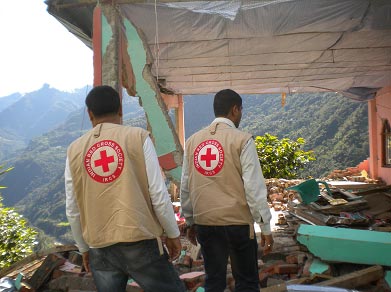
18th September 2011, would be a date that Sikkim would like to push aside in the back pages of memory and get on with life. The horrors of the evening can be well explained only by those who had experienced the nightmare of a devastating earthquake measuring 6.9 magnitudes on the Richter scale. But memories of the faces of near and dear ones lost, the picture of the ravaged surroundings, broken homes, derailed lives and that horrifying sound shall never fade from the minds of the survivors who have lived to tell the tale.
The persistent adverse climatic conditions made it quite difficult for all the humanitarian workers to reach out to the affected victims with aid. To make conditions worse heavy rainfall and dense fog engulfed the area. Precious time was passing by and no support was at hand from the outside world. People were anxious and anguished. Despite hurdles Indian Red Cross teams were the first one to reach there, befriend those people and listen to their harrowing experiences.
It was a heart rending situation at Chungthan, one of the badly affected areas of the earthquake. It was a gloomy sight from all angles, reported a Red Cross Volunteer, “I saw elderly people who generally command their emotions, breaking down, quiet and bewildered children, sobbing women who shrieked loudly in between.
The grief and pain that the locals shared with the Red Cross responders diminished their agony quite a bit. The basic of psyho- social support is to listen patiently and Red Cross volunteers are attuned to such situations.
Relief material consisting of non food items such as blankets , tarpaulin sheets, cooking stoves and kitchen sets were distributed among the victims. A watsan( Water and Sanitation Unit) unit was installed that provided clean drinking water to 2000 families in the Chungthan camp. The volunteers became a part of the lives of the affected eating, drinking sleeping and facing same adversities. They were the nearest empathizers who had ascended on their soil to wipe their tears.
Oinam, Suresh, Rajesh , Krishnamurthy and Dr Nishant along with all others volunteers shared, “ Though scenes of devastation are usually the same but each story is new, each face is fresh , difficult to forget.”
While returning the volunteers refused a chopper ride that was in use to rescue the needy and traveled through a 10km long tunnel on a truck, for heading towards Gangtok. They covered next 12 kms on foot via Naga camp to reach there.
During the operation 999 shelter kits were sent to the identified eight villages. The shelter kit consist of tools and materials that helped in the reconstruction of broken home or set up a temporary make shift shelter. The volunteers briefed and demonstrated the usage of the kits to the beneficiaries. The local people were happy with the Red Cross service which was reflected when a young boy approached the Red Cross team with a desire to become a Red Crosser.
“The aftermath of a disaster is always the same, difficult to absorb and impossible to set aside. The mourning cries of an orphaned child, unspeakable grief of a bereaved mother, anguish of the affected, picture of a ravaged terrain, broken homes and untold stories of derailed lives” remarked a volunteer, “ But I’m sure they will soon re-build their homes and life , Red Cross is always behind someone in need”.
Dissemination Section- Indian Red Cross Society.